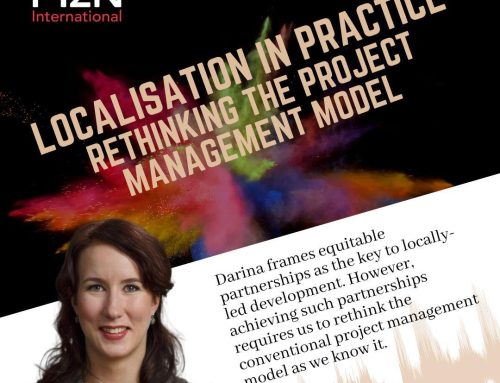The way we think about charities is fundamentally torn between two ideals. On the one side, we want non-profit organisations to strive for high-end efficiency, professionally running campaigns and programmes, squeezing costs and increasing impact. On the other hand, we are fond of NGOs as social actors, free from the profit motive, culturally different and kind, not just to their beneficiaries, but also to their employees.
The way we think about charities is fundamentally torn between two ideals.
Worryingly, this ideological divide sometimes leads to a lack of focus and clarity within charity boards and management as epitomised in Merlin’s financial distress this summer.
Merlin, a UK- based charity with more than 4500 staff across 18 countries and donor funding in excess of £69 million, found itself in severe financial distress as it almost exclusively relied on governmental donors for funding. The trouble lies in the fact that government funds cannot be used to finance certain important support operations, causing Merlin to become severely underfunded, leading to widespread rumours about the charity’s sustainability.
The anatomy of Merlin’s troubles is simple and shows just how torn its business model was. After incurring a loss of £1.9 million in 2011 (2012 results were at the time of writing), Merlin used its shrinking reserves to keep programmes running. Eventually, management used an overdraft facility, incurring £49,000 in bank interest over 2011, simply to continue operating.
What Merlin’s financial difficulties reflect is a basic reality about funding: Relying on governmental funding alone is not sustainable and will, ultimately, result in the running out of cash. This is because governmental funding is not only likely to reduce overall, but it also comes with restrictions on its usage.
Government donors no longer simply fund NGOs. Today, they buy programme results. And whilst many NGOs, including Merlin, are able to deliver impressive programmatic results, they are not addressing the problem that government funding generally does not allow sufficient money to fund critical business operations that charities cannot do without (e.g. fundraising, reporting, training, situation analysis, etc.). The costs of these important functions are unlikely to be covered by the small overhead allowance that government donors permit. The strategy for any sustainable funding must therefore include a diversified mix of funding sources.
The strategy for any sustainable funding must therefore include a diversified mix of funding sources.
Merlin’s management, however, must have been confused about its strategy. Although the charity was well aware of the problems, it failed to diversify its funding base.
In 2011, more than 70 per cent of Merlin’s income was provided by only six donors, five of them from Europe. Such a concentration of funding sources left the charity vulnerable to reducing aid budgets and donors pulling away. Unfortunately, this is exactly what happened.
Having fewer donors not only raises the question of financial sustainability, but also of programmatic independence. Over 2010 and 2011, about 90 per cent of Merlin’s income was restricted for use only on projects identified by donors. Rather than being an independent charity, Merlin was more like a contractor implementing government- funded programmes.
Fortunately Merlin’s merger with Save the Children prevented further financial troubles and, for now at least, Merlin continues to operate.
However, Merlin’s failure to diversify its funding base is symptomatic of how torn we feel about the business models of NGOs. Merlin was unable to see its specialised mission, its capacities, its centralised structure and its medium size as a strategic asset. In fact, Merlin’s management repeatedly acknowledged these factors, but framed them as problems to overcome, rather than as asset to work with. After all, there are ample options for NGOs to turn to in order to diversify their funding base.
For example, Merlin failed to successfully offer its global reach, and the knowledge and specialised skills of its staff in providing frontline medical services and health care sector building to generate income through consulting or other commercial contracts. Such income-generating work would not only have generated much needed unrestricted cash, but may have also provided a chance to influence governments and the private sector, thereby advancing its mission.
Unfortunately, like Merlin, many charities fail to capitalise on viable strategic opportunities, leaving them to look for private-sector examples of how to run and lead an organisation. However what those hailing the private sector as an example of how non-profit organisations should be run often forget, is that running a charity is much harder than managing a business.
It is true that successful businesses use their assets and market standing efficiently, constantly finding better uses for them and rooting out inefficiencies. The profit motive naturally drives competition and efficiency, both internally within the business, and externally amongst business. And whilst valuable lessons can and should be drawn from successful businesses, we must not forget that these lessons need to be adapted simply because charities work differently.
A charity’s mission is not to generate profit, but ironically this actually increases the need for a well-developed funding strategy and financially sustainable operations
For example, a business’s profit margin is also its safety cushion, able to absorb some delays, errors, and unforeseen circumstances, whilst the small surplus that most NGOs work on, if any, does not generate substantial levels of comfort. As a result, NGOs have an increased need to run a tight ship and thereby ensure that such financial losses are avoided, or at least minimised. A charity’s mission is not to generate profit, but ironically this actually increases the need for a well-developed funding strategy and financially sustainable operations that ensure that the organisation is available to its beneficiaries in the long term.
The need for developing better funding strategies becomes even more pressing when considering that the operations of most development and humanitarian NGOs are more international, use a more complex funding structure and work in less predictable environments than comparatively sized private sector operations.
What makes it harder again, is the fact that most charity employees are motivated by a match between their and the organisation’s values, not necessarily in efficient business operations and sustainable funding.
All the above results in a lesson that Merlin failed to learn: To successfully build a financially sustainable and programmatically independent charity we do not need to glorify business operations, but we do need to acknowledge that charities are in the business of doing good. NGO management must and should learn from successful business operations to develop a more sustainable funding strategy. This includes new ways of doing things, driving internal efficiency and diversifying funding sources. It includes NGOs partnering more often with each other and with the private sector. It includes NGOs increasing internal efficiency in operations by doing what is necessary, outsourcing what others can do better (and possibly cheaper) and not doing what is redundant. In short, it requires charity management to be business smart, without glorifying business ethos as the holy grail of NGO operational models.
In order to be a successful NGO, you need to think like a charity but learn from successful businesses.
Finally, the case of Merlin’s financial troubles once again teaches us how to resolve the somewhat twisted way we think about charities: In order to be a successful NGO, you need to think like a charity but learn from successful businesses.
by Christian Meyer zu Natrup
The article was printed in BOND’s The Networker magazine and reproduced in several aid & development blogs.





